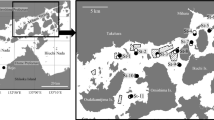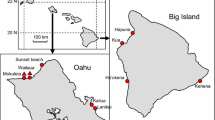Abstract
The hard clam Mercenaria mercenaria burrows deeper into the sediment when the predaceous sea star, Asterias forbesi is present. The supposition that this increase in burial depth represents an escape response designed to reduce predation was tested experimentally by regulating clam burial depth through manipulation of the amount of sediment available for burial. Mercenaria maintained at zero depth were eaten by Asterias at greater rates than those held at ordinary burial depths (2.5–3.0 cm). These clams in turn were eaten at greater rates than those maintained at escape depths (4.0–4.5 cm). The results unambiguously establish an anti-predator function for the burrowing response, as well as underscoring the protective function of the fossorial habit. They are not confounded by behavioral predator food preferences, inherent differences between prey species, or debilitating side effects of preventing prey from escaping. Mechanisms by which the burrowing response may reduce predation are discussed and observations on the unreported clam-digging behavior of Asterias forbesi are presented.
Similar content being viewed by others
Literature Cited
Anger, K., U. Rogal, G. Schriever, and C. Valentin. 1977. In situ investigations on the echinoderm Asterias rubens as a predator of soft-bottom communities in the western Baltic Sea. Helgol. Wiss. Meeresunters. 29:439–459.
Ansell, A. D. 1969. Defensive adaptations to predation in the mollusca. Symp. on Mollusca Proc. Mar. Biol. Ass. India (ser.3):487–512.
Armstrong, L. R. 1965. Burrowing limitations in pelecypoda. Veliger 7:195–200.
Bullock, T. H. 1953. Predator recognition and escape responses of some intertidal gastropods in presence of starfish. Behaviour 5:130–140.
Dayton, P. K., R. J. Rosenthal, L. C. Mahen, and T. Antezana. 1977. Population structure and foraging biology of the predaceous Chilean asteroid Meyenaster gelatinosus and the escape biology of its prey. Mar. Biol. 39:361–370.
Doering, P. H. 1976. A burrowing response of Mercenaria mercenaria (Linnaeus, 1758) elicited by Asterias forbesi (Desor, 1848). Veliger 19:167–176.
Edwards, D. C. 1969. Predation on Olivella biplicata including a species specific predator avoidance response. Veliger 11:326–333.
Feder, H. M. 1972. Escape responses in marine invertebrates. Sci. Am. 227:92–100.
Gonor, J. J. 1965. Predator-prey reactions between two marine prosobranch gastropods. Veliger 7:228–232.
Gonor, J. J. 1966. Escape responses of North Borneo strombid gastropods elicited by the pedatory prosobranchs Aulica vespertilio and Conus marmoreus. Veliger 8:226–230.
Laws, H., and D. F. Laws. 1972. The escape response of Donacilla angusta Reeve (Mollusca: Bivalvia) in the presence of a naticid predator. Veliger 14:289–290.
Loosanoff, V. L. 1958. Underwater studies of starfish behavior and evaluation of control methods. Bull. Biol. Lab. Milford 22:1–5.
Mackie, A. M., and P. T. Grant. 1974. Interspecies and intraspecies chemoreception by marine invertebrates, p. 105–141. In P. T. Grant and A. M. Mackie (eds.), Chemoreception in Marine Organisms. Academic Press, New York.
Margolin, A. S. 1964. The mantle response of Diodora aspera. Anim. Behav. 12:187–194.
Margolin, A. S. 1975. Responses to sea stars by three naticid predators. Ophelia 14:85–92.
Mauzey, K. P., C. Birkeland, and P. K. Dayton. 1968. Feeding behavior of asteroids and escape responses of their prey in the Puget Sound region. Ecology 49:603–619.
Moitoza, D. J., and D. W. Phillips. 1979. Prey defense, predator preference, and non-random diet: The interactions between Pycnopodia helianthoides and two species of sea urchins. Mar. Biol. 53:299–304.
Montgomery, D. H. 1967. Responses of two haliotid gastropods (Mollusca), Haliotis assimilis and Haliotis rufescens, to the forcipulate asteroids (Echinodermata), Pycnopodia helianthoides and Pisaster ochraceus. Veliger 9:359–368.
Phillips, D. W. 1975. Distance chemoreception-triggered avoidance behavior of the limpets Acmaea (Collisella) limatula and Acmaea (Notoacmaea) scutum to the predatory starfish Pisaster ochraceus. J. Exp. Zool. 191:199–210.
Phillips, D. W. 1977. Avoidance and escape responses of the gastropod mollusc Olivella biplicata to predatory asteroids. J. Exp. Mar. Biol. Ecol. 28: 77–86.
Phillips, D. W. 1978. Chemical mediation of invertebrate defensive behaviors and the ability to distinguish between foraging and inactive predators. Mar. Biol. 49:237–243.
Pratt, D. M., and D. A. Campbell. 1956. Environmental factors affecting growth in Venus mercenaria. Limnol. Oceanogr. 1:2–17.
Schoener, T. W. 1971. Theory of feeding strategies. Annu. Rev. Ecol. Syst. 2:369–404.
Smith, L. S. 1961. Clam-digging behavior of the starfish, Pisaster brevispinus (Stimpson, 1857). Behaviour 18:148–153.
Snedecor, G. W., and G. Cochran. 1967. Statistical methods. Iowa State Univ. Press, Ames. 593 p.
Steel, R. G. D., and J. H. Torrie. 1960. Principles and procedures of statistics. McGraw Hill, New York. 481 p.
Turner, H. J. 1955. How clam drills capture razor clams. Nautilus 69:20–22.
Van Veldhuizen, H., and D. W. Phillips 1978. Prey capture by Pisaster brevispinus (Asteroidea: Echinodermata) on soft substrate. Mar. Biol. 48:89–97.
Author information
Authors and Affiliations
Rights and permissions
About this article
Cite this article
Doering, P.H. Reduction of sea star predation by the burrowing response of the hard clam Mercenaria mercenaria (Mollusca: Bivalvia). Estuaries 5, 310–315 (1982). https://doi.org/10.2307/1351754
Issue Date:
DOI: https://doi.org/10.2307/1351754




